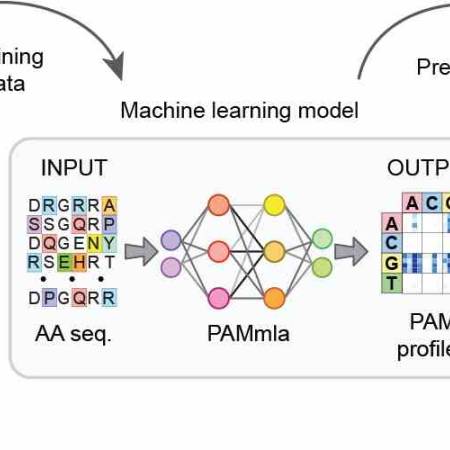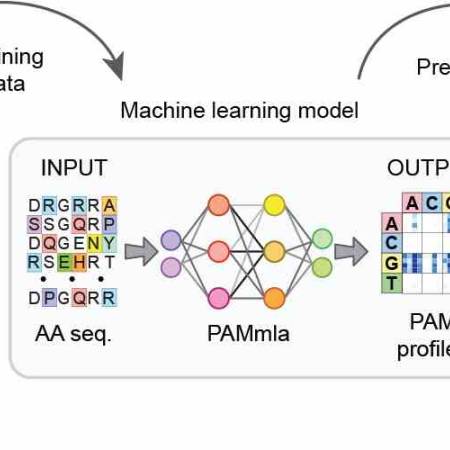THE LATEST
AI meets DNA: Scientists create custom gene editors with machine learning
Wed, Apr 23rd 2025  In a remarkable convergence of artificial intelligence and biotechnology, researchers at Mass General Brigham have introduced a groundbreaking method for engineering "bespoke enzymes" specifically designed for gene editing. This innovative...
In a remarkable convergence of artificial intelligence and biotechnology, researchers at Mass General Brigham have introduced a groundbreaking method for engineering "bespoke enzymes" specifically designed for gene editing. This innovative...
German-built simulations offer hope for honeybee conservation
Fri, Apr 18th 2025  Scientists in Germany, funded by the Federal Ministry of Food and Agriculture, have developed a new approach to studying the effects of pesticides on honeybee colonies, providing promising strategies for their protection. By integrating...
Scientists in Germany, funded by the Federal Ministry of Food and Agriculture, have developed a new approach to studying the effects of pesticides on honeybee colonies, providing promising strategies for their protection. By integrating...
NASA shows how advanced algorithms transform raw data into meaningful...
Thu, Apr 17th 2025  NASA’s Chandra X-ray Observatory has introduced new three-dimensional (3D) models of cosmic objects, providing valuable insights into the universe's mysteries. These models, created with advanced theoretical frameworks and computational...
NASA’s Chandra X-ray Observatory has introduced new three-dimensional (3D) models of cosmic objects, providing valuable insights into the universe's mysteries. These models, created with advanced theoretical frameworks and computational...
AI-generated 'synthetic scarred hearts' revolutionize atrial fibrillation...
Wed, Apr 16th 2025  In a groundbreaking development, researchers at Queen Mary University of London have unveiled an artificial intelligence (AI) tool capable of generating synthetic yet medically accurate models of fibrotic heart tissue. This innovation...
In a groundbreaking development, researchers at Queen Mary University of London have unveiled an artificial intelligence (AI) tool capable of generating synthetic yet medically accurate models of fibrotic heart tissue. This innovation...
Tulane researchers use AI to improve diagnosis of drug-resistant infections
Sat, Apr 12th 2025  In a time when drug-resistant infections pose a significant threat to global health, the need for innovative solutions has never been more critical. Recent advancements in technology have provided a glimmer of hope, as researchers at Tulane...
In a time when drug-resistant infections pose a significant threat to global health, the need for innovative solutions has never been more critical. Recent advancements in technology have provided a glimmer of hope, as researchers at Tulane...
Unraveling the mystery of intermediate-mass black holes: A Chinese...
Wed, Apr 9th 2025  The cosmos has long been a realm of mystery and fascination, with black holes standing out as enigmatic entities that continue to captivate the minds of astronomers and astrophysicists. Recently, a discovery has sparked curiosity and raised...
The cosmos has long been a realm of mystery and fascination, with black holes standing out as enigmatic entities that continue to captivate the minds of astronomers and astrophysicists. Recently, a discovery has sparked curiosity and raised...

AI meets DNA: Scientists create custom gene editors with machine learning
Wed, Apr 23rd 2025In a remarkable convergence of artificial intelligence and biotechnology, researchers at Mass General Brigham have introduced a groundbreaking method for engineering "bespoke enzymes" specifically designed for gene editing. This innovative...

German-built simulations offer hope for honeybee conservation
Fri, Apr 18th 2025Scientists in Germany, funded by the Federal Ministry of Food and Agriculture, have developed a new approach to studying the effects of pesticides on honeybee colonies, providing promising strategies for their protection. By integrating...

NASA shows how advanced algorithms transform raw data into meaningful...
Thu, Apr 17th 2025NASA’s Chandra X-ray Observatory has introduced new three-dimensional (3D) models of cosmic objects, providing valuable insights into the universe's mysteries. These models, created with advanced theoretical frameworks and computational...
POPULAR
- USC shows a more accurate picture of brain aging
- UVA unveils the power of AI in accelerating new treatment discoveries
- AI's potential for wildfire detection: A critical examination
- Nvidia sales grow 78% on AI demand
- Breakthrough or hype? Questions arise over 'low-cost' computer claims
- Unveiling the future of mosquito repellents: Machine learning leads the way
- Caltech's landmark breakthrough in quantum networking: A true revolution or just theoretical hype
- The unusual phenomenon of protein lassoing: Myth or fact?
- Hospital del Mar explores novel pathways in drug development
- Woolpert, Teren leverage geospatial tech for global energy solutions
THIS YEAR'S MOST READ
- A new method for modeling complex biological systems: Is it a real breakthrough or hype?
- A new medical AI tool has revealed previously unrecognized cases of long COVID by analyzing patient health records
- Woolpert welcomes Amar Nayegandhi as the Global Head of Technology and Innovation
- New supercomputer models show intensifying wildfires in a warming world
- USC shows a more accurate picture of brain aging
- UVA unveils the power of AI in accelerating new treatment discoveries
- Disheartening news from space: Webb Telescope likely fails to detect life on exoplanet
- Woolpert strengthens global technological expertise with Carl Lucas as CIO
- Retired U.S. Army Maj. Gen. Tom Tickner joins Woolpert to provide support for federal clients, projects
- Switching a 2D metal-organic framework from insulator to metal: Exploring unusual conductive behavior
MOST READ OF ALL-TIME
- Largest Computational Biology Simulation Mimics The Ribosome
- Complex Concepts That Really Add Up
- Silicon 'neurons' may add a new dimension to chips
- Blue Sky Studios Donates Animation SuperComputer to Wesleyan
- Linux Networx Accelerators Expected to Drive up to 4x Price/Performance
- Humanities, HPC connect at NERSC
- TeraGrid ’09 'Call for Participation'
- Turbulence responsible for black holes' balancing act
- Cray Wins $52 Million SuperComputer Contract
- SDSC Researchers Accurately Predict Protein Docking
MOST READ
- Woolpert, Teren leverage geospatial tech for global energy solutions
- AI model predicts multi-resistance in bacteria: Unveiling the power of big data
- Unraveling the mystery of intermediate-mass black holes: A Chinese perspective
- Tulane researchers use AI to improve diagnosis of drug-resistant infections
- AI-generated 'synthetic scarred hearts' revolutionize atrial fibrillation treatment
